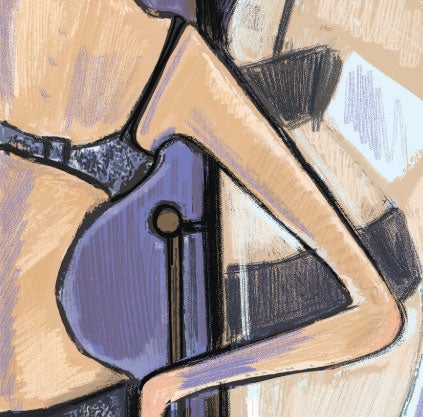 No matter who you are, your body image plays a role in your life. It may empower you – or, in some cases, it may defeat you, ravaging your health, ruining your relationships, destroying your life. One alumna has fought this battle – continues to fight this battle – and what she has learned in this constant struggle has changed everything for her.
No matter who you are, your body image plays a role in your life. It may empower you – or, in some cases, it may defeat you, ravaging your health, ruining your relationships, destroying your life. One alumna has fought this battle – continues to fight this battle – and what she has learned in this constant struggle has changed everything for her.
By Emily Rogers ’13
Trigger warning: This piece contains graphic imagery of living with an eating disorder.
Anorexia: Even as I look at the word, it seems foreign. Like a foggy memory of jutting hipbones, exposed ribs, birdlike shoulder blades. It belongs to another Emily, another person. Someone small inside of me, perhaps. But it is me, it was my body. The blurry years of 15, 16 and 17 were marked with identically portioned meals, doctor’s visits and blood tests. “Emily, your iron is too low.” “Emily, please try and eat something else.” “Emily, this isn’t healthy.”
It started out slowly, the summer after my freshman year of high school. I used those exercise cards you  pull out of fitness magazines. I did them every day and I felt stronger. Then I started to diet: I ate fat-free everything. No chips, no white bread, no peanut butter. Only fruits and vegetables. I lost weight – I lost a lot of weight. And people noticed, they complimented me on it. It felt good; it felt like I was winning.
pull out of fitness magazines. I did them every day and I felt stronger. Then I started to diet: I ate fat-free everything. No chips, no white bread, no peanut butter. Only fruits and vegetables. I lost weight – I lost a lot of weight. And people noticed, they complimented me on it. It felt good; it felt like I was winning.
I didn’t admit to myself it was an eating disorder until October, when my mom took me to the doctor, where they gave me an emergency blood test to determine if I needed to be hospitalized. I only thought I was being healthy, that I could finally have the body that I wanted, that society told me I needed. It turns out I was sick. It was a disease. I went home that night and laid on my bedroom floor in my underwear, sobbing, feeling my hip bones stab my sides.
It only got harder after that, the therapy and process of recovery. It’s like pulling your lungs out of your body and you’re running to get them back. That’s how hard it was for me to eat something different, something more. Like when I made a peanut butter and banana sandwich, to my exact specifications – 1/3 of a banana and only 1 tablespoon of peanut butter – and ended up crying in the bathroom in my high school cafeteria because it was so painful and hard and frustrating for me to eat that sandwich.
The funny thing about eating disorders is that they can morph, they are fluid and alive within you. The more comfortable I got eating different foods, the more rigid I got with exercising. One hour at the gym every day, minimum. My muscles weren’t hard enough, weren’t toned enough. If I stopped, I’d get fat. Going to the gym became the center of my day; I felt off and uncomfortable and twitchy until I was able to go. I called it exercis-arexia. This stuck around for about a year until it morphed again.
Binge-eating disorder: Something within me snapped, I stopped caring. The body I wanted suddenly wasn’t worth the pain I felt. I ate and I ate. All the foods that I had forbidden myself to eat. I gained 70 pounds in three months. I hid food. After school I would buy boxes of cookie dough and muffins and eat until my stomach hurt. I tried to throw up a few times, but I couldn’t get the hang of it. Instead, I kept eating, and my body changed again. The pain didn’t go away, I still hated my body. I hated my disease and myself. I hated my bright-red stretch marks, marks of my shame.
Recovery is a process. One that I don’t think ever ends. It’s been eight years and it’s still a part of me. My stretch marks have faded into a translucent white; I exercise again, and some foods still turn my stomach inside out. But I am not my disease anymore; it does not control me or own me. I love my body, finally.
Zumba helped me love my body, my shapely, soft body. My body, a body that went through hell. And now, my body, she dances. When I do Zumba, I take back my body. I take back the once-protruding hip bones, the now fleshy ribs. I claim them as my own. I move them and I move with them. I meringue with verve, I salsa with passion, I shake it like I mean it. Zumba allows me to reclaim my once-broken body. At first, I was intimidated by the footwork and coordination I thought necessary to do Zumba, but a friend, a fellow eating-disorder survivor, persuaded me to go to a class. I tripped over my own feet and didn’t care. I felt alive. I didn’t feel the need to hide my body or make excuses for it. I just moved. Zumba helps me tap into my sexuality. My hips make wide arcs and I feel love for them.
I check the clock: It’s 5:05 and Zumba starts three blocks away in 10 minutes. I’m already wearing my spandex and sports bra. I’ve got my Zumba shoes on, and I’m fully equipped with a water bottle. There are no excuses, even though I’m tired and my limbs feel like they are stuck in Jell-O when I try to move them. But when I get to the gym and see my friend Amanda smiling at me, I feel more energized. She asks if I have any song requests for class; I respond, “I want to feel like a badass, a bomb chick. I want to dance out my feelings.” She nods and smiles. Amanda gets it.
The music starts. I feel the bass beating in my chest. “Keep your abs tight and your hips loose,” Amanda shouts to the class. Suddenly, my limbs feel light and nimble, but they also feel strong and fierce. I’m stomping and gyrating and sweating and smiling. My body is mine again, we move together as one. I’m no longer looking at her from the outside, picking out imperfections and storing them to dwell on later. Now, I’m feeling her, every inch of her, and we’re luscious.
Now I dance. I dance for me. I dance for Emily – the old Emily, and the new. I dance to celebrate this body that is worth shaking.
– Emily Rogers ’13 is a volunteer services coordinator for the SCORE Association in Washington, D.C.
Illustration by Angela Dominguez




